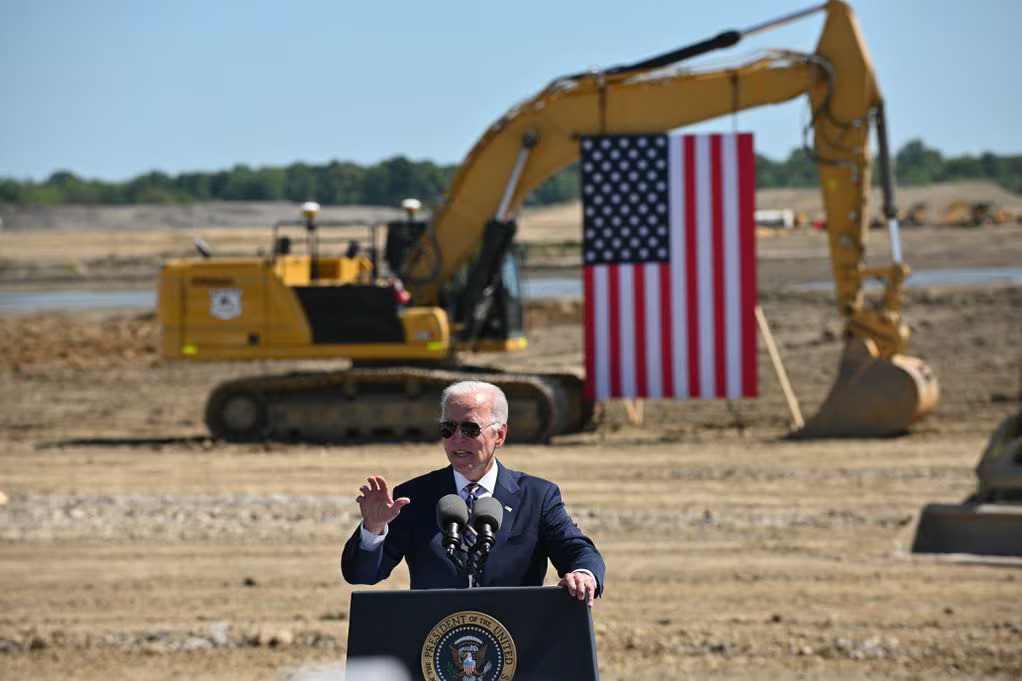Construction of two new semiconductor plants by Intel, currently under construction in New Albany, is on schedule, said Ellie Akopyan, communications and media relations manager for Intel.
Intel began construction at the end of 2022 and is building two plants simultaneously, information provided by Linda Qian, director of communications for the company's Ohio office, who is responsible for public relations. Currently, 1,000 construction workers are on site, and the company expects this number to grow to 7,000.
According to the Ohio Department of Development, builders and suppliers are coming from all over the state, including the Dayton-Springfield-Butler County region. Intel expects that the local region will also provide technicians, engineers, administrative staff, and other support workers. Ten local colleges and universities participate in a statewide program funded by Intel to train workers for these jobs.

"As the largest economic development project in Ohio's history, Intel will have a significant impact on the entire state," - said Stephanie Kainat, Vice President of Strategic Initiatives at the Dayton Area Chamber of Commerce. "We know that more than 350 Ohio businesses are suppliers to Intel, and we expect that number to grow as other aspects of the project are implemented."
"Since laying the foundation in late 2022, our construction has been proceeding on schedule. Typical timelines for building semiconductor plants range from 3 to 5 years from foundation laying, depending on various factors," - says Akopyan.
Bechtel is the general contractor for the plants being built at the New Albany International Business Park, located northeast of Columbus in Licking County. Each plant, known as a "fab," will have an area of at least 250,000 square feet.
In addition to hiring construction workers, Qian said the company has also started hiring employees for supporting roles.
Employment will reach 3,000 once both plants are fully operational, and Akopyan reported that the average salary will be $135,000 per year.
The plants will operate 24 hours a day, 365 days a year, with workers on 12-hour shifts consisting of three to four days and three to four days off, said Qian.
According to Intel, the two plants in Ohio will create 10,000 indirect jobs.
"This is highly advanced, modern manufacturing, a huge facility producing tiny microchips that we all rely on in everyday life," - said Qian.
Semiconductors are critically important components in various products, including mobile phones, consumer electronics, satellites, electric vehicles, defense systems like F-35 fighters, as well as applications for artificial intelligence, quantum computing, biotechnology, and clean energy.
Qian states that the initial project cost in Ohio, estimated at $20 billion, has increased to $28 billion.
According to a preliminary agreement signed in March between Intel and the U.S. Department of Commerce, the company will receive support under the federally funded CHIPS and Science Act.
"This is very important. There is a significant cost difference between investing here in the U.S. and operating a plant in Asia. About 30%," - says Qian. "So, the CHIPS and Science Act will help bridge that gap."
The Ohio state government also granted Intel $600 million to support the two new plants, requiring the company to invest $20 billion, hire 3,000 people, and have an annual payroll of $405 million by December 31, 2028, according to the Ohio Department of Development.
Based on an Intel newsletter provided by Qian, the company's total investment in Ohio could ultimately reach $100 billion upon full development of the site for eight plants.
"Once again, I emphasize that we are very pleased to build such facilities in Ohio," - said Qian. "And I believe this project will benefit residents across the entire state."
The competition for manufacturing American semiconductors
Qian states that Ohio plants are likely to produce different types of semiconductors, including high-tech ones needed for artificial intelligence, but it is still too early to specify the exact range as the industry is changing very rapidly.
"Yes, given how the industry operates, we have to start building new plants without knowing exactly what will be produced there," - says Qian. "It will be what we call cutting-edge logic. These will be among the most advanced manufacturing processes in the world."
Semiconductors were invented in America, but despite the U.S. being a world leader in semiconductor design, research, and development, only about 10% of semiconductors are produced in the U.S., according to the Ohio Department of Development newsletter.
Long-standing concerns about the need to increase semiconductor microchip production in the U.S. have intensified due to COVID-19-related supply chain disruptions and shortages, as well as increasing geopolitical tensions such as China’s disputes with Taiwan, a primary supplier of these microchips.
The bipartisan CHIPS law, signed by President Joe Biden in 2022, aims to stimulate domestic semiconductor manufacturing and R&D, utilizing nearly $53 billion in federal incentives.
"Almost all advanced microchip manufacturing in the entire industry was moved abroad, to Asia, many years ago," - Biden said in his March 20 speech, announcing a preliminary agreement with Intel, which provides the company access to funding under the CHIPS Act for two new plants in Ohio, as well as for construction and expansion projects in New Mexico, Arizona, and Oregon.

"That is why today’s investment matters so much. We will enable leading US semiconductor production to return here, to America, after a 40-year pause."
According to the preliminary agreement, Intel will receive up to $8.5 billion in direct funding under the CHIPS Act for project implementation. The company may also access up to $11 billion in federal loans and a tax credit of up to 25% on more than $100 billion in qualified investments, as stated in the company's press release.
The proposed funding will help Intel realize its plan to invest over $100 billion over five years in "expanding U.S. microchip manufacturing capabilities and critical infrastructure, as well as accelerating the development of new technologies such as artificial intelligence," - said in the March press release announcing the preliminary agreement.
It is expected that projects in four states will create over 10,000 new permanent jobs and nearly 20,000 construction jobs, as well as indirectly supporting over 50,000 jobs in suppliers and related sectors, according to Intel.
"Today is a pivotal moment for the U.S. and Intel as we work towards creating the next major chapter of American semiconductor innovation," - said Intel CEO Pat Gelsinger in the March press release.
"Artificial intelligence accelerates the digital revolution, and everything digital depends on semiconductors. Supporting the CHIPS Act will help Intel and the U.S. stay at the forefront of the AI era, as we build a resilient and secure supply chain for the future of our country."


